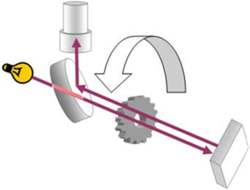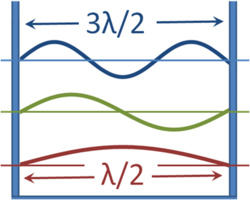Speed of light
In physics, the speed of light in vacuum, commonly denoted by c, is seen as one of the fundamental constants of nature. The main postulate of special relativity asserts that the velocity of light is independent of the motion of the light source; the speed of light is the same in any inertial frame (coordinate system moving with constant velocity with respect to the universe as a whole), irrespective of whether the light is emitted by a body in uniform motion or by a body at rest.
In addition, in special relativity the speed of light is the limiting speed for transfer of information, and no causal effect may travel faster than the speed of light.[1]
Like any theory, special relativity has been subject to experimental test, and agrees with observations to the accuracy attainable up to the present. Some aspects of the theory are not directly measurable, so its validity is based upon those predictions that can be checked. For example, the Michelson-Morely experiment measures the two-way speed of light, not the one-way speed of light.[2] Some other properties of the speed of light in vacuum that are supported by experiment to date are: propagation is the same in all directions (isotropy); independent of polarization (no dichroism); independent of field strength (magnitude of the associated electric and magnetic fields); and independent of the frequency (color) of the light (no dispersion).
History
Galileo Galilei suspected that light has a finite velocity and claimed that he tried in vain to measure it. About forty years later, in 1675, the Danish atronomer Rømer estimated that it takes about 11 minutes (660 seconds) for light to travel from the Sun to the Earth. He could make this estimate by observing eclipses of the first satellite of the planet Jupiter. A few years earlier Cassini had deduced from observations of Mars that the distance from Sun to Earth was about 139⋅106 km, so that the speed of light was estimated to be 2.1⋅108 m/s, which is about 30% lower than the modern value. Later Rømer's value was refined, by similar astronomical observations, to 499 seconds. In 1849 Fizeau determined by Earth-bound experiments that c is 3.15⋅108 m/s.
Modern work brought this value down to just under 3⋅108 m/s. In particular, measurements of the resonant frequencies of cavities with dimensions a known number of wavelengths, and the relation c=λf relating wavelength and frequency to the speed of light resulted in c = 299,792.5±3 km/s in 1950.[3] As shown in the figure, the wavelength of waves in a box that are forced to have zero amplitude at the walls can have only values that are multiples of a half-wavelength. For microwaves, zero amplitude at the walls results because the electromagnetic fields associated with the wave cannot penetrate a metal wall, so the light intensity inside the wall is zero. Naturally, such walls are an idealization and real walls will permit some slight penetration.
In any event, with the imposition of a condition for nodes at the walls, allowed wavelengths can adopt only restricted values. Because wavelength λ (determining the spatial behavior) and frequency f (determining the time dependence of the wave) are related to the speed c (at which the wave would propagate if it were free, and not in a box) as λ=c/f, the frequencies also have only discrete values. By choosing the wavelength by specifying the dimensions of the box, and by measuring the associated frequency, a value for c=λf is found.
A brief history of later developments is found in Sullivan.[4]
Relation to the metre
See also the discussion at metre.
The universality of speed of light in vacuum, and its propagation being independent of complications like dichroism, anisotropy, dispersion and nonlinearity meant that all observers readily could measure lengths using the transit time of light. In 1975 the 15th CGPM (Conférence Générale des Poids et Mesures, General Conference on Weights and Measures)[5] recommended a defined speed of light in the SI system of units:
which is, of course, the same thing as stating the metre is traversed with the transit time of 1/299 792 458 s. The numerical value for c in principle could be chosen to be any numerical value whatsoever, because a change in value corresponds simply to a different time-of-flight, and thus traversal of a different length, and thus a different length for the standard metre. The length of the standard metre, of course, is an arbitrary unit selected by international convention.[6] A few years later[7] this suggestion was adopted, and the metre was redefined as the length of the path traveled by light in vacuum during a time interval of 1/c of a second, and the notation c0 suggested for the defined value of the speed of light in vacuum.[8] The value for c0 was selected to correspond well with the measured speed of light using the then standard metre defined in terms of a wavelength of krypton-86 radiation. That choice was made to limit any dislocation in switching to the new international standard of length. Reference was made to commonly employed methods and corrections to insure measured transit times in real media could be adjusted to refer to classical vacuum.
In 1968, the second was defined as the duration of 9 192 631 770 periods of the radiation corresponding to the transition between the two hyperfine levels of the ground state of the caesium-133 atom.[9] Greater precision in time determinations became possible with the development of microwave and laser optics, allowing extension of time measurements to higher frequency transitions in the optical regime. Comparison of lengths by comparing their transit times is now far more accurate than methods based upon counting wavelengths.
In Si units, because of the use of a defined value c = c0:[10]
“Note that consequently the speed of light is and remains precisely 299 792 458 meters per second; improvements in experimental accuracy will modify the meter relative to atomic wavelengths, but not the value of the speed of light!”
-W Rindler, Relativity: Special, General, and Cosmological, p. 39
To this remark it may be added that the defined speed of light c0 has by virtue of its definition the properties of isotropy, no dichroism, no dependence upon field strength, and no dispersion, regardless of what experiment may discover about, for instance, the propagation of light in some real medium approximating ideal vacuum, for instance, propagation in outer space or in good terrestrial vacuum. A discovery of anisotropy in terrestrial vacuum, as an example hypothetical situation, would not change c0, but would instead lead to a specification that the measurement must be corrected for anisotropy to refer terrestrial vacuum to the reference medium classical vacuum, or (perhaps) that the standard metre had to be measured in a particular standard direction when using terrestrial vacuum.
Other systems of units
In systems of units where lengths are not measured by times of transit, but are independent units (for example, wavelengths of light at a chosen frequency), improvements in measurements lead to more accurate determination of the speed of light. However, it may be noted that the comparison of lengths even in such units is more accurately made by comparing the transit time of light along the lengths, because transit times are more accurately measured than are the lengths of the paths as multiples of the fundamental length unit, at least using present techniques.
Notes
- ↑ For further discussion , see Roger Penrose (1996). Shadows of the mind: a search for the missing science of consciousness. Oxford University Press, pp. 220 ff. ISBN 0195106466.
- ↑ For a discussion of the experimental verification of the special theory, see for example David Bohm (1996). “Chapter XXII: Experimental evidence for special relativity”, The special theory of relativity, 2nd ed. Psychology Press, pp. 83 ff. ISBN 041514809X.
- ↑ See L Essen (Dec. 17, 1950). "The velocity of propagation of electromagnetic waves derived from the resonant frequencies of a cylindrical cavity resonator". Proc. Royal Soc. London vol. 204 (No. 1077): pp. 260-277.
- ↑ Donald B Sullivan (circa 1991). Speed of light from direct frequency and wavelength measurements. NIST.
- ↑ Bureau International des Poids et Mesures (Brochure on SI units, 8th ed.; pdf page 65, paper page 157) From the website of the Bureau International des Poids et Mesures
- ↑ The article metre describes several of these arbitrary definitions, including the 1791 definition as 1/10 000 000 of the length of the meridian of Paris from the north pole to the equator.
- ↑ Resolution 1 of the 17th meeting of the Conférence Générale des Poids et Mesures (CGPM)(1983). 1983 definition of the metre. BIPM. Retrieved on 2011-03-19.
- ↑ See, for example, the official definition and the BIPM brochure on the SI units: The International System of Units §2.1.1 Unit of length (metre), page 112, 8th edition of 2006.
- ↑ Resolution 1 of the 13th meeting of the Conférence Générale des Poids et Mesures (CGPM) (1967/68). 1968 definition of the second. International Bureau of Weights and Measures (BIPM). Retrieved on 2011-03-19. A note was added in 1999 to correct for nonzero temperatures; see Unit of time (second). SI brochure, Section 2.1.1.3. BIPM. Retrieved on 2011-03-19.
- ↑ Rindler, W (2006). Relativity: Special, General, and Cosmological, 2nd ed.. Oxford University Press, p. 39. ISBN 0198567316.

